User Centred Design applied to a luminaire
Introduction
The aim of this work is to design and develop a luminaire which satisfy users’ needs and expectation making use of User Centered Design methodology. It approaches users so as to provide users with a product adapted to individual’s needs. The luminaire is intended to a target characterised of being young adults, between their 20s and 30s in the midst of the transition to adulthood. As das Dores Guerreiro & Abrantes (2004) states, this process has two dimensions: experiences and adventures without major commitments; and a second dimension oriented towards maturity based on responsibility and stability. Despite being this research conducted in the Portuguese context, the geographical and historical proximity with Spain, make its conclusions extensible to our country. Even though Amichai-Hamburger & Vinitzky (2010) concluded that personality definitely influences the way in which social networks are used, it also confirms they undeniable trend of digital and online relationships and interactions. Social networks are of quite importance for this target in their daily life.
The use of light is implicit when it comes to night-time activities. Either direct or indirect light, its brightness, colour, and other characteristics are essential to perform any activity. However, the available means tend to be adapted to users’ needs. It is clearly illustrated when luminaires are intended for functions that they were not design for. Choosing the suitable light for each activity is important: while white light helps concentrate, warm tones foster relaxed atmospheres (B Li, QY Zhai, JB Hutchings, MR Luo, & FT Ying, 2017). On this basis, there are a handful of different options, yet, which does the user really need? Some years ago, the answer to this question may have arisen directly from the sketching notebook; without even wondering if that was a great idea from the user’s perspective. It can be found many examples of products and services which were launched that backfired afterward as they did not ask themselves this simple question.
For example, “Google Glasses” were put on the market in 2013 as an innovative application of new technologies in the fashion industry. There was no apparently technical problem, yet person and users’ issues. As Klein, Sørensen, Sabino de Freitas, Drebes Pedron, & Elaluf-Calderwood (2020) explain, it was conceived as a solution in search of a problem. Thus, not only did the product involved an awkward appearance, but also designers did not clearly explain the purpose of such a product. Consequently, private data and the lack of indirect user consent surrounded the controversy.
Nowadays, there are many methodologies and tools that approach product and service users with a view to empathising and connect with them; such as “Google Design Sprint” and the Stanford methodology about “Design Thinking” (Meinel, Leifer, & Plattner, 2011) (Mendonça de Sá Araújo, Miranda Santos, Dias Canedo, & Favacho de Araújo, 2019).
User-Centered Design (UCD) emerges in the 80s with this aim. This methodology is based on insights that are consequence of a user research (Gladkiy, n.d.) (Baek, Cagiltay, Boling, & Frick, 2008). There is no fixed scheme of how to perform this methodology. On the contrary, it is based on the choice of the most suitable techniques through which observe, learn, and ask users in different ways about the studied topic. The correct analysis of all this collected data is critical in order to reflect the research insights into the devised products. DCU is therefore empathetic, because it pays special attention to users, and iterative, as design process goes back and forth collecting and analysing data as many times as necessary. Feedback is key to this methodology (Gladkiy, n.d.).
Once the context is known, design requirements have to be set: needs, desires, fears… The design process is characterised by a diffuse beginning. The Figure 1 shows how this process clarifies at the time the research and design stage progress (Sanders & Stappers, 2008). The research is followed by the design stages take into consideration mainly the users’ specifications, but the economic and technological feasibility as well. Lastly, prototyping and implementation take place.

Figure 1. UCD development structure (Sanders y Stappers, 2008).
The user research, and first work phase, is focused on understating and analysing users and their light habits. The by-product found insights will lead to a product design stage which put together users’ needs and desires. The research is not only oriented to users, but also to light lamps characteristics. Thus, there will be a full picture of the context. Traditional and creative techniques are applied so as to know habits, interactions, and concerns in the matter of household lighting.
Methodology
Taking DCU as a reference, there have been conducted different related and not related user techniques (like luminaire market research). They were applied in order to approach users and to understand them better. It is down below described the related user methods performed: shadowings, short contextual interviews, personas, and cultural probes.
Shadowings
This was the first conducted technique in search of an initial contact with individuals and the product. Basically, the researcher gets involved in users’ daily life by following them during a predefined period of time (Milton & Rodgers, Looking, 2013).
Unlike a formal research set, this contextual method benefits from a first-hand experience of actual people’s complexities and culture, as a direct result of observations in a daily environment. It turns easier to deepen into their lives and witness behavioural patterns in real environments. In other words, shadowings studies what people do instead of what people say, delivering a more realistic perspective (Milton & Rodgers, Looking, 2013). The possibilities of this tool could be summarised through Khoi Vinh, Adobe Lead Designer, quote about product design (2014): “Asking users to adopt new behaviours or even modify their existing behaviours is very, very hard.”
There are several benefits such as real-time data collection and detailed patterns of behaviour information. In addition, it is focused on users, fostering an empathetic perspective of them. On the other hand, shadowings are high-time consuming and they also require a complex analysis of the collected data (Think Design, n.d.).
Short contextual interviews
Once shadowings were over, short contextual interviews were chosen to follow up. Interviewing the same stakeholders that during the shadowings was on the grounds of comparing what they say they do with what they really do. It depicted a full picture of user’s environment and context.
Although interviews are rather a quite common qualitative technique, this work intends them to be particularly short and contextual. This means that they take place while the user is using the product which is being studied along with them. It enables the above-mentioned comparison. They are characterised by a short and open script. It is preferable to listen rather than speak to better understand what they are saying, without focusing on getting precise answers.
The interview script with the questions can be found in the appendix. It provides the different addressed topics related to lighting to later contextualise the developed results.
Personas
This technique consists of fictitious characters based on real observations of users that consequently have specific needs and goals. These personas arise to represent user clusters within the demographic target that shares interest, products, services, brands… in other words, lifestyles (Milton & Rodgers, Personas, 2013).
As a versatile tool, it can be used in many ways such as trigger material to provoke and expose opinions during group sessions and workshops (Ilstedt, Eriksson, & Hesselgren, 2017), or as it is intended in this work: to communicate the research insights in order to facilitate their interpretation and to keep sight of the target (Milton & Rodgers, Case Study - MJV Tecnologia e Inovaçao: SMS Coach, 2013) (Wever, van Kuijk, & Boks, 2008).
Archetypes were devised to express the research outcomes in such a way that they were useful in later stages. Design is therefore guided by fictitious personas that indeed are based on real facts. Moreover, it introduces a huge amount of qualitative data in a visual, aesthetic, and summarised manner. Personas help prioritise the target and design requisites, embodying needs, and potential design opportunities.
It is important to build this set of personas around data and information which have been collected during the research, rather than based on stereotypes and assumptions. It will otherwise lead to a misleading result since the archetype might likely not adjust to reality and the personas would like inconsistent with the research. The following benefits can be stated about personas technique (Miaskiewicz & Kozar, 2011):
- Keep focus on the target: product development emphasises on users and their needs.
- Product requisites are prioritised by determining if the main problems are being solved.
- It challenges previous assumptions and stereotypes about the researched users.
For all that, this method improves communication with the design team, so it is helped understand users and devise and build around them (Milton & Rodgers, Personas, 2013).
Cultural Probes
This technique was devised in 1999 by Bill Gaver, current co-director of the Interaction Research Studio and professor of the Design Department both at London University. His aim was to obtain elderly perspective so as to trigger the involvement of elderly in their communities as a result of the research (Gaver, Dunne, & Pacenti, 1999).
It consists of a carefully devised kit which is delivered to the target which the project is working with. Its intention is to provoke, expose and capture inspiring answers that describe the relationship between the individual and products, services, spaces… (Milton & Rodgers, Learning, 2013).
The kit is composed of several items which enable the collection of a wide variety of information in a creative way. For instance, it is common to include a disposal camera, postcards, diary, maps… These items are characterised by (Mattelmäki, 2006):
User self-documentation. The participant documents the required material to be later used during the
1. User-Centered design process.
2. Looking at personal context and perceptions. By sharing personal interpretations, the design team obtains an enlightening material to adapt products to users.
3. Exploring new design opportunities instead of solving already known problems. It is fostered by the open spirit of the method since these tasks may lead to unexpected and surprising results.
Furthermore, many designers and researchers have made use of cultural probes to make their own interpretation in their projects with different goals and approaches. Ultimately, this technique can be customised shaped and devised according to what the researcher wants to obtain since it provides (Mattelmäki, 2006):
1. Inspiration: enrich and support the design team inspiration.
2. User’s information.
3. Engagement: product users take part in the ideation stage.
4. Dialogue: an intimate communication channel is built between users and researchers/designers.
Cultural probes are intended in this project to evoke new ideas and points of view during the ideation phase in the leisure and relaxation context. This more personal information that participants provided complemented the research insights. All together pursuit the main research goal, designing a luminaire according to users’ needs.
Results
This section contains the different design process stages: research, ideation, and product development. Each of them is directly consequent of the insights of the previous stage.
Research
Shadowings
They were conducted with five participants within the established target. It was addressed intensively, taking five uninterrupted hours periods from 7 p.m., once dusk has fallen, onwards. On this basis, the observer took note of behaviours and habits since dusk approaches until users go to bed.
Among the behavioural patterns and habits observed, it is worth mentioning leisure activities and study and relaxation time. Some of the notes collected while shadowings are shown in Figure 2. Three columns are displayed according to: 1. Observer feelings about the observed environment; 2. Users’ Lighting characteristics; 3. Activities and light habits of observed individuals.
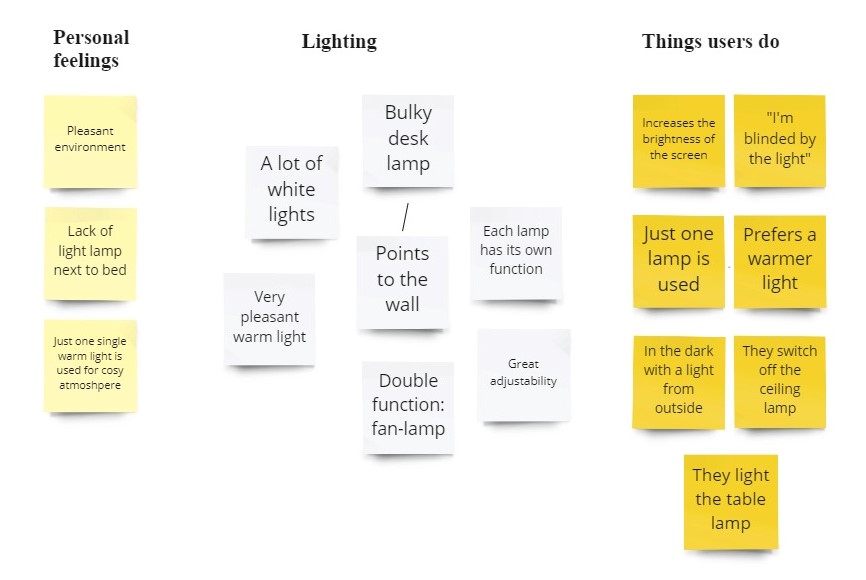
Figure 2. Notes classification..
The personal feelings are related to both users and the environment that surrounds them: behaviours, lights, and their body language. Of particular interest was the continuous feeling of lacking a suitable table lamp for loosened atmospheres and relaxation. This issue is frequently solved by the typical study desk lamp despite not giving the appropriate light (either intensity or tone), or by the ceiling lamp which usually provides a profoundly intense light for loosening times.
The following block is related to the light lamps’ characteristics: light, functionalities, and the way they were used. The five participants had their own desk lamp. Some were more adjustable and intense than others. This adjustability was sometimes used for adjusting the intensity depending on the necessity. However, this was not intended for work, but for relaxing by pointing them to the wall, the table, or any other element in the room so that devised their own tenuous space.
Regarding the third and last column, observed light habits are presented. They all used to interact with their complete set of domestic light depending on what they were doing (cooking, dine, watch TV…). Although there were plenty of possibilities, some complained about some of them due to the lack of adequate lighting.
Shadowings brought to light the need of an appropriate lighting for relaxed and resting moments, even though users tend to overcome this problem by the already installed lighting possibilities, such as desk and ceiling lamps that are far enough to not dazzle or pointing elsewhere.
Short Contextual Interviews
The five shadowed participants were interviewed following this special format to contras the qualitative information collected before. The script was ideated to keep an open structure focused on their spare time. The more relevant insights are presented down below as a result of the data analysis. Although diverse conclusions were drawn, the most significant findings are related to users’ habits.
The most repeated lighting habit was the tendency of staying in the dark. There is a huge preference for warm and specially tenuous lights, leading to a scenery where darkness defeats lighting. This situation is often related to loosening and peace of mind states. The answer given by one interviewee: “the comfort of a light has to do, to a considerable extent, with the darkness it leaves” perfectly reflects and support this first conclusion. It is also remarkable the lack of resources either in terms of lamps or sockets and switches. As a result, domestic luminaires are often used for distinct functions from those for which they were designed; like a desk lamp pointing at the wall instead to the workspace.
When the luminaires characteristics and flaws topic was brought in, interviewees claimed that they had some troubles when it comes to small pieces on the surface. This complaint would be interpreted as a desire of a more robust and solid design aesthetic. While some argued not having even tried to fix them, others affirmed cheeking them frequently to put them in place. Lastly, it is particularly noteworthy that they sometimes find it difficult to adjust their luminaires or light, i.e., having this functionality is not always convenient.
With a view to iteratively improving the script and the way the questions and topics were mentioned, the answers were analysed after each interview. Furthermore, this approach prevented from interferences among interviews and users’ perceptions. Some questions did not provide the expected information and were substituted by others more adequate focused on the aim of the interview.
Insights
An insight is defined as a new point of view which lead to reconsider conventionalities as a consequence of human being behaviour observation. It is a finding about motivations and necessities that drive human actions (Dalto, 2016). They are key to identify relevant evidence to generate value (Design Thinking en Español). This section gathers the most important insights extracted from the user-centered qualitative techniques:
1. Deficient lightning systems for users’ routines. It has been proved in the shadowings with their behaviours as well as in the interviews through their words, that young adults did not have the most appropriate lighting for their nigh-time activities. These moments are usually fulfilled with hobbies and any kind of leisure and relaxation. In many cases, the used luminaires would be exchanged if there were the opportunity.
2. Dual functions are attractive, but not completely useful. Although it may look glamorous, regardless of the object or the means in which it is presented, dual functions are not usually fully used.
3. The given light is as much important as the darkness left. During the research, some participants complained about the strength of the light, that “can be seen with closed eyes.” This new interpretation appeals to twist this conventionality when considering light. It focuses on the degree of darkness that a subtle light leaves. It helps devise peaceful environments through pleasant lighting.
4. There are luminaries whose functionality does not converge with its usability. This was observed during the research, lamps with a great degree of adjustability but with difficulties to be used. For example, one of the studied lamps had some joints that were loosened, and it was complex to fix. Another one had such adjustability, that it was not easy and intuitive to set.
5. A luminaire cannot be reduced only to the light it gives. The lamp aesthetic is also important. It is always considered before buying, although not everybody values it to the same extent. In spite of being a subjective matter, aesthetics concerns are visible and recognisable by paying special attention to small details.
6. Lamps have a long lifespan. They are intended to last as much as possible since people do not tend to change them. The best example of this insight is the presence of ceiling and desk lamps which is characteristic of childhood and teen years. The atemporal trend can be embodied without categorised the product design more than more than enough. Furthermore, not only is the robust appearance related to aesthetic, but also to durability.
7. Warm light makes people feel more comfortable and relaxed. As obvious as it may seem, it is important to be able to demonstrate this directly from the user’s own words and experiences. This type of light encourages a relaxed and pleasant environment.
Personas
Figure 3 shows the three created personas to personify users’ needs and motivations during the design and ideation stage. They are based on the previous described insights.
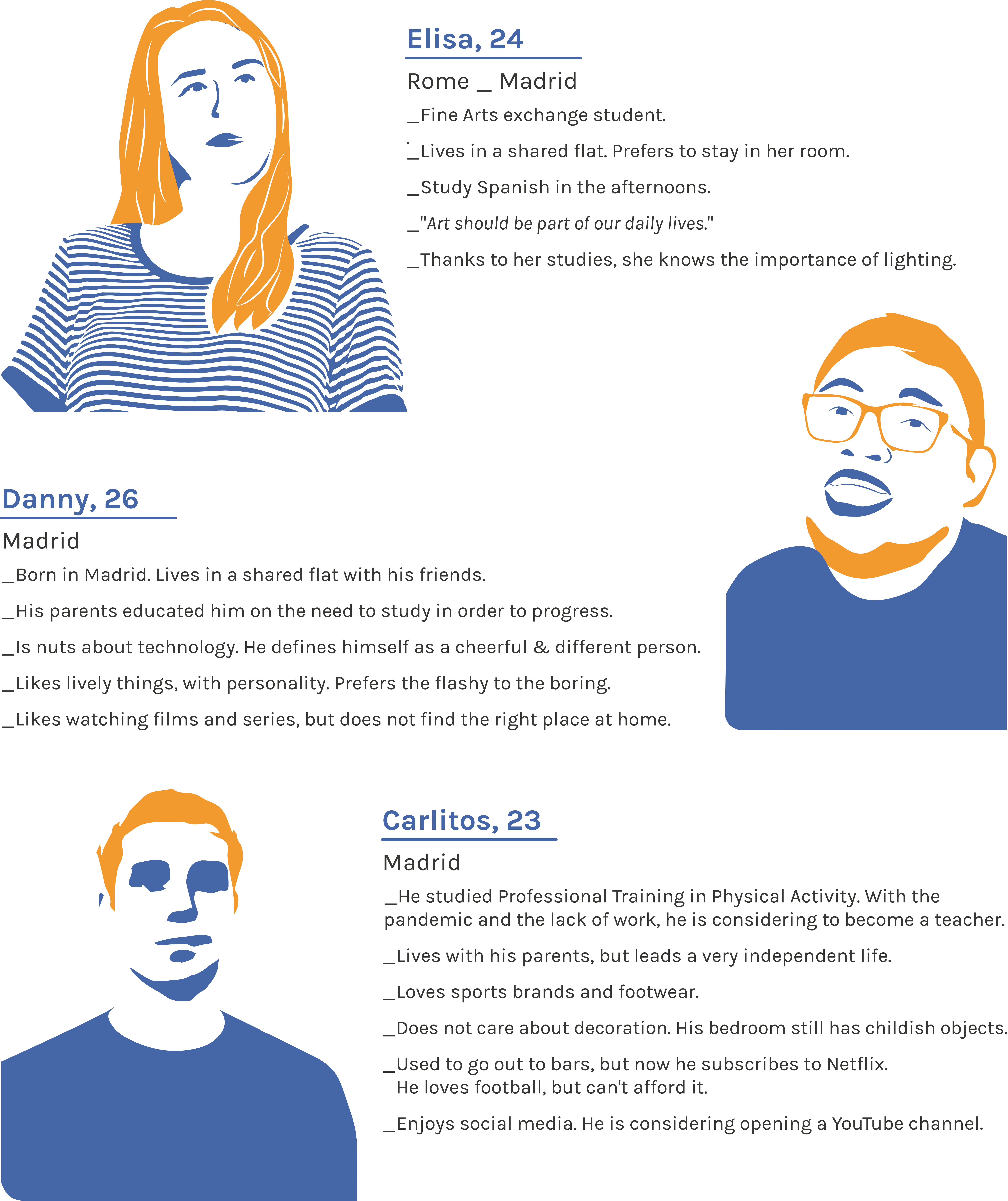
Figure 3. Personas: Profiles generated as a result of user research.
Design challenge
The aim of the Design Challenge is to emphasise users’ needs found during the research phase. The challenge is named as: boosting loosening moments during leisure time.
Habits, aesthetic preferences, hobbies, and different contextual user’s elements emerged during the research. It was observed how studying and work tend to absorb the entire day to day life, even during the afternoons. Little spare time is left during the evening, that is when artificial light is required and starts to cause problems: very strong light, too focus, so white… These issues worsen as the more time is devoted to leisure and free time activities, which might lead to disgust and unease.
Even if one tends to adapt one’s means to what he or she wants to do, it is much more interesting and attractive to have the right means to do it. This is what the challenge is all about, a luminaire that boosts the preferred activities for relaxation and leisure. It is about inviting people to devote more time to themselves and to give more importance to their habits and tastes by offering the right means, in this case, lighting systems that do not hinder the enjoyment of moments of relaxation.
Ideation
Cultural Probes
The kit components were prepared to conduct cultural probes once the research was finished. As explained before, the main goal was its inspiring and intimate nature. Four sets were distributed between the project target and to different people from the research. It was devised to be completed within a pair of weeks. There was completely freedom to accomplish all the task in any specific order and time. The kit consisted of a series of postcards and a photo-documentation tasks. The content of each set was (see Figure 4):
- One envelope.
- An introductory card explaining the tasks.
- Seven postcards.
- A card with the themes to be photographed.
- A USB stick to save the digital images.
- Stickers with recipient and sender addresses for sending the answers.
- A stamp for returning the envelope.
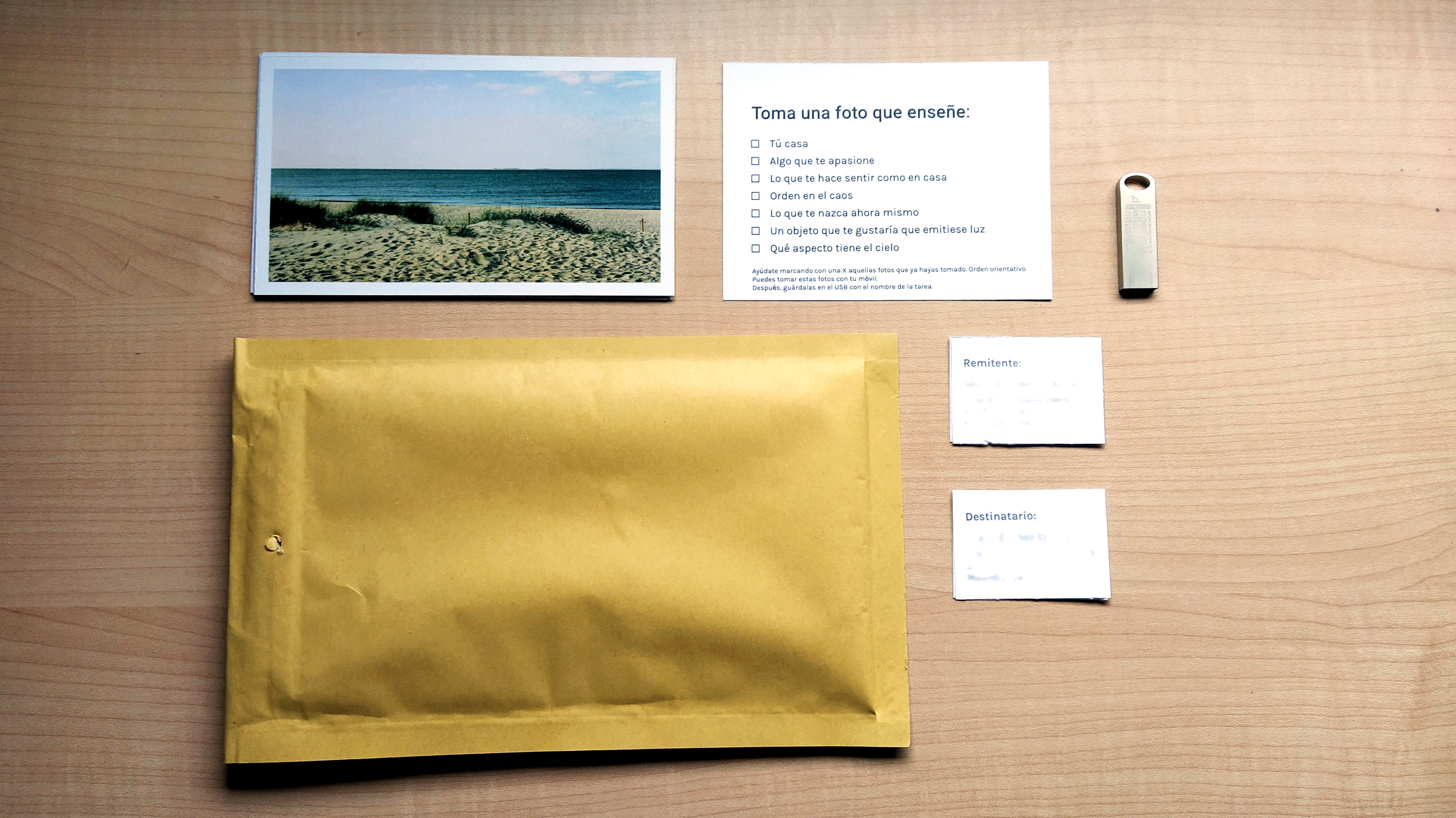
Figure 4. Kit designed for this technique
Both the photo-documentation instructions and the questions on the postcards varied in difficulty, with some tasks being more thought-provoking and others easier and more tangible. The postcards had a main image related to the back, where there was a question that had to be subsequently answered. The tasks and questions are shown in Table 1:
When all the responses were received, they were analysed. The main conclusion that could be drawn was the importance of nature, as it was related to quietness, darkness, the place to watch the sunset, and so on. In fact, the beach was the most repeated answer when asked for a favourite place to be. Hence, nature will be a source of inspiration later, as participants themselves highlighted their need to be more aware of it.
They were also asked what kind of activities they did when they wanted to disconnect. It is therefore possible to learn what routines and activities users like to do in accordance with the design challenge posed. The habits to disconnect were very varied: drawing, sitting or lying-in bed, eating, playing the piano, watching a series... Although some require higher light intensity, they are activities that are characterised by needing rather dim and warm light, creating cosy environments.
The task of reflecting on what made them feel at home in the photographs assignments is noteworthy. Figure 5 shows how each of them chose a different object. The final design may draw on these ideas to generate the same feeling, such as the cosy shape of the slipper or the warmth of a coffee and a fireplace.

Figure 5. Photo-documentation task: What makes you feel at home?
These three tasks were the most relevant to later elaborate new ideas and concepts. The luminaire development will be based on nature as inspiration, on hobbies for its customisation and on everyday objects to emulate their formal and emotional language in order to integrate with them. The rest of the answers also contributed to get to know the participants’ points of view, way of thinking and to better understand their contexts.
The four participants were enthusiastic about this technique, showing their interest in the project and the next steps to be taken. In other conditions with more time and budget available, more elements could have been added to the kit to enrich the process. An important aspect for the development of cultural probes was to select profiles within the audience with certain characteristics such as: reflective personality, with an interest in art and people curious to know themselves and explore new products and interactions.
Exploring ideas
After summarising the research phases and the previous technique, the emerging ideas were explored. The portable lamp concept seeks to fulfil one of the most important users’ concerns. While not everyone in the interviews indicated this as a preferred option, it is a feature that makes the lamp adaptable to use, allowing it to be placed wherever it is desired.
Figure 6 presents another area of work that aims to bring nature and the beach, mentioned in the responses to the postcards, closer together. The intention is to sensorially transport the user through those effects of light and shadow so characteristic of the water on the seashore by means of glass surfaces. The aim is to bring that feeling of calm from the beach to the home, where the aim is to enhance moments of disconnection.
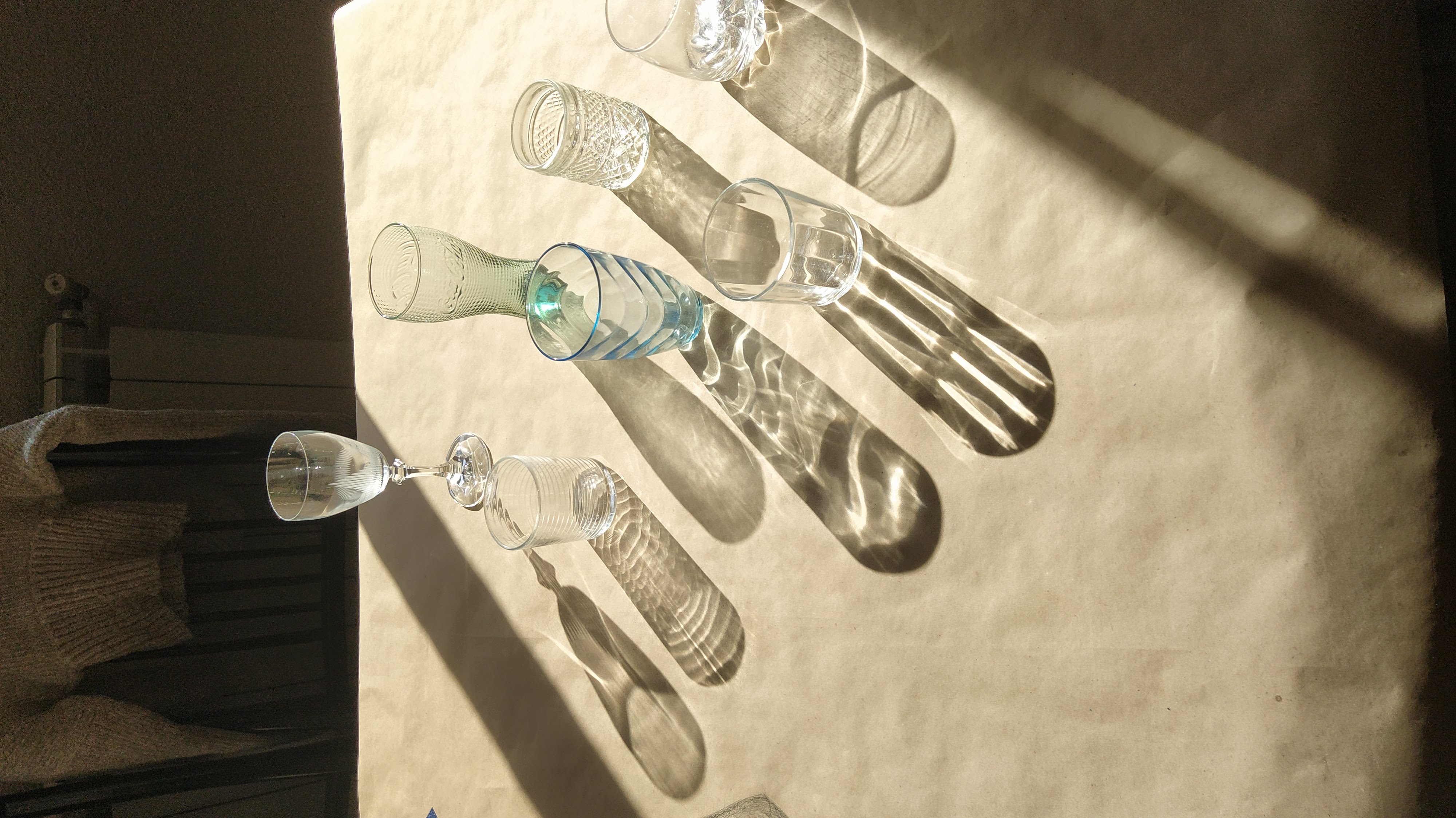
Figure 6. Light and shadow effects through glass walls.
As can be seen in the figure, reflections appear when the glass walls are penetrated by concentrated and powerful light. This effect, in terms of physics and optics, is called caustics. It is the result of refraction and reflection of light on a curved surface.
Light dimming is an issue that arose during the shadowings. Sometimes the light was too bright for the intended use, and the other way around. Being able to dim according to the activity is a technology that is available nowadays. It could enhance the experience of those relaxing activities by providing adequate lighting that makes one want to spend time on them
The light provided by the luminaire will be to set the mood of a room. It will foster warm and cosy environments where the light is as important as the darkness it leaves, encouraging a more reflective and restful state of mind.
These concepts were explored and developed, using sketching techniques. Design ideas were defined and rejected until the one that best incorporated these premises was found. The sketch in Figure 7 shows the design proposal for what would later become the final design of the luminaire: a portable, dimmable lamp that creates light effects both when it is switched on and when natural light passes through the glass walls.ç
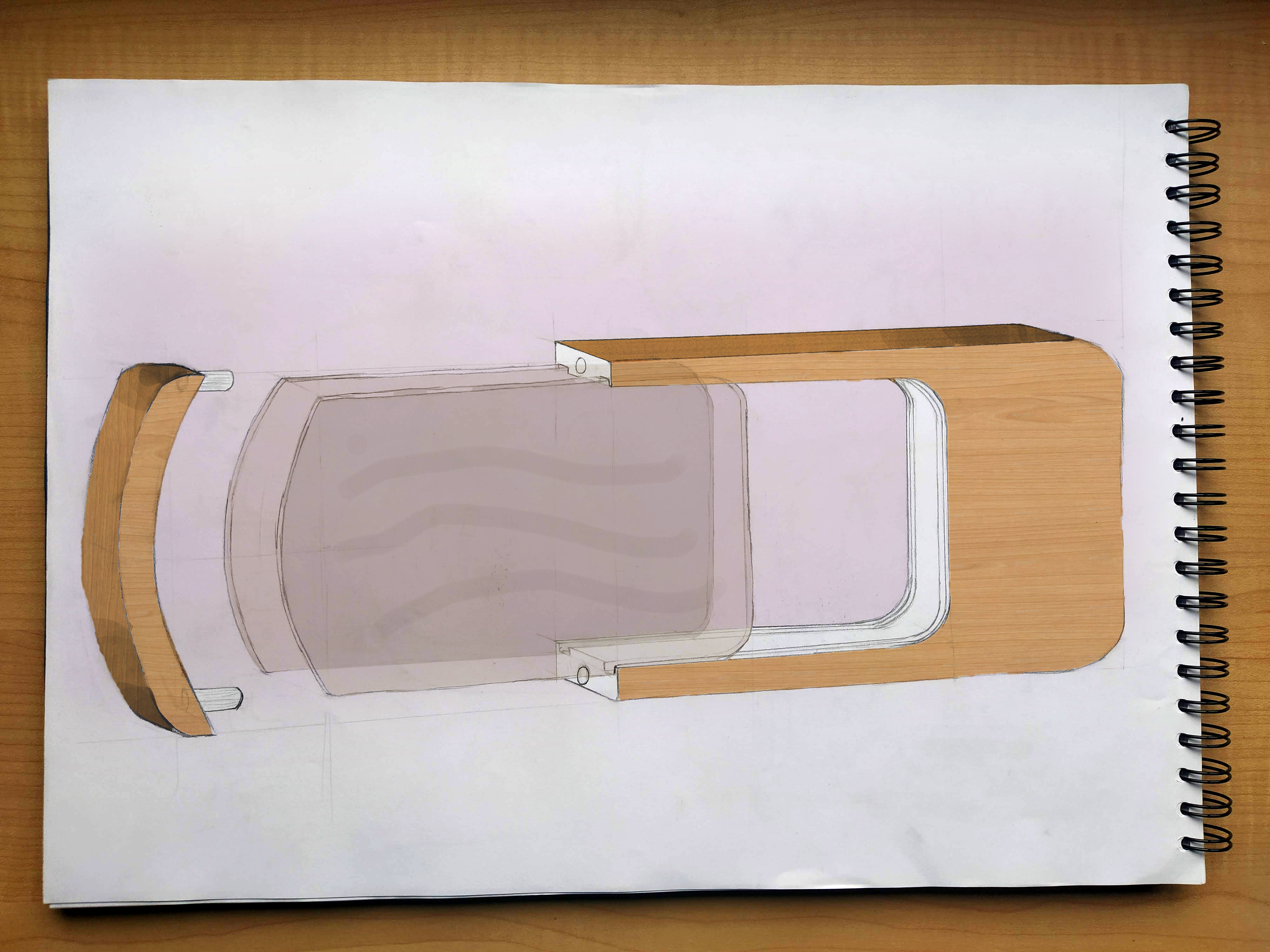
Figure 7. Assembly of the design proposal.
A model was built to complete the definition process. It was used to determine the dimensions and positions of different elements to optimise the interaction with the product. Figure 8 captures the work created during this process.
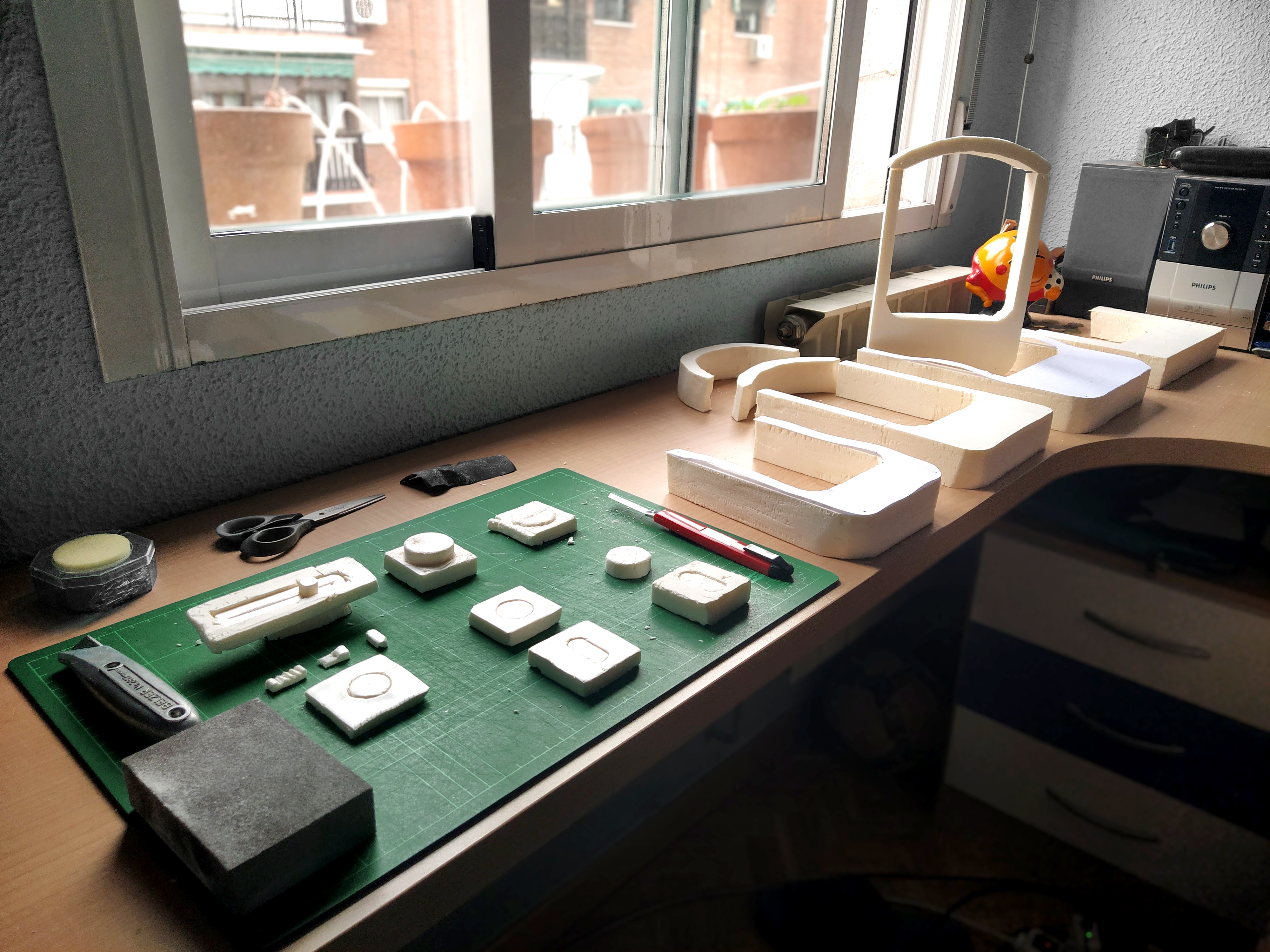
Figure 8. Iterative process of building a model.
Rapid prototyping allows experimenting with physical objects of any complexity rapidly (Chee Kai & Kah Fai, 2000) observing diverse ideas more clearly. It also helps identify problems in a product that might go unnoticed if working solely with digital tools where there are factors that are more difficult to predict. A greater understanding of the shapes and volumes of the final design is achieved. As shown in Figure 8, its nature involves exploring ideas and adding and removing elements while testing different combinations. It makes use of inexpensive materials such as foam polystyrene as a tool before turning to specialised 3D modelling software (Milton & Rodgers, Quick-and-dirty prototypes, 2013).
Development stage
The luminaire finally designed is shown in Figure 9. Its main purpose is to promote moments of relaxation during spare time. It is a portable table lamp with dimmable intensity. In addition, it can be placed either vertically or horizontally, so that it can be positioned as desired.
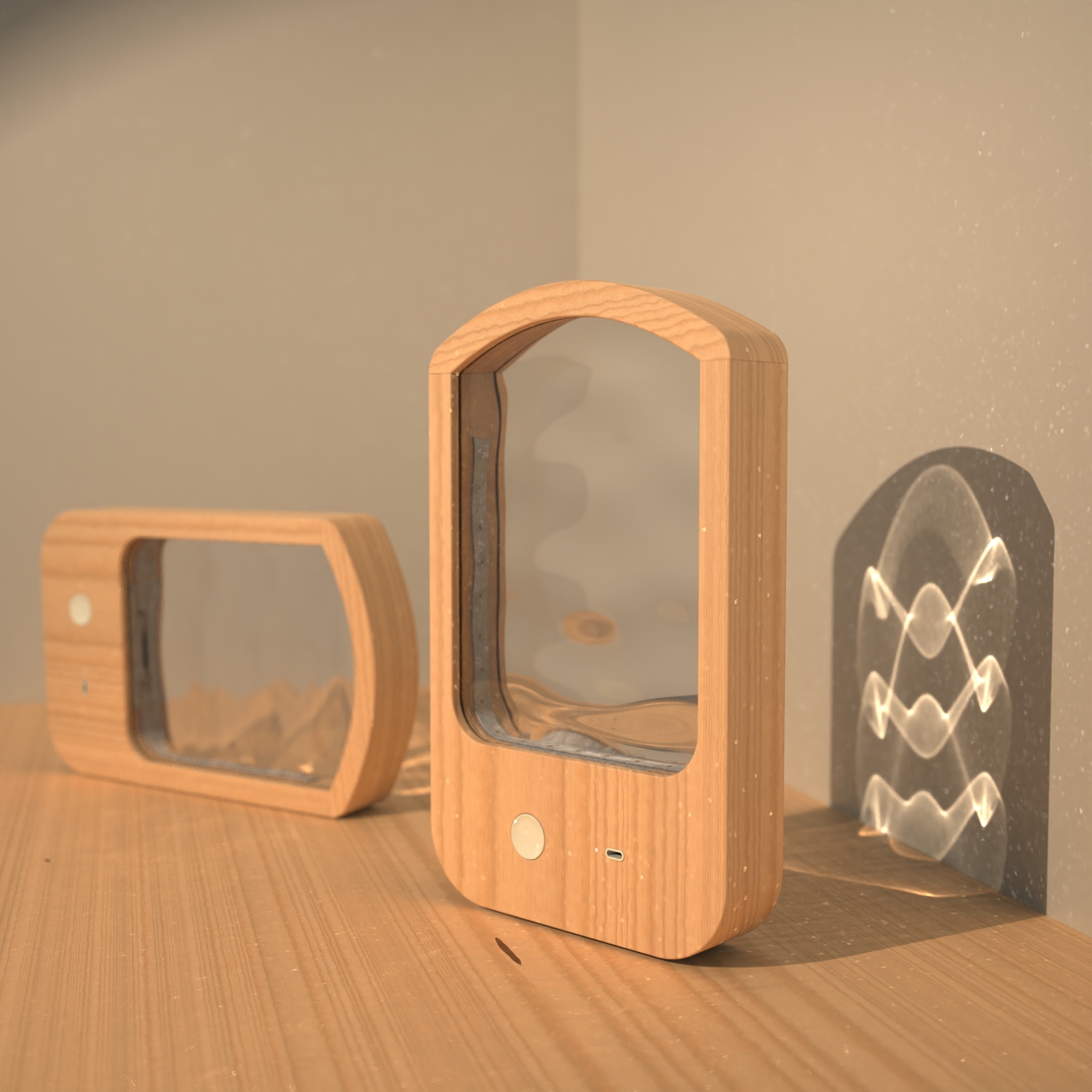
Figure 9. Light effects when light passes through it.
The most characteristic feature is the creation of light effects through reflections and shadows cast by the glass walls. These simulate the characteristic effects of water when sunlight shines through it.
They are associated with moments of calm and relaxation, such as a summer sunset on the beach or by the river.
As can be seen in Figure 9, reflections appear when concentrated and powerful light passes through their glass screens because of the physical effect of caustics.
The intensity of the light can be adjusted by means of the touch button with four dimming levels (0% - 25% - 50% - 100%).
Figure 10 shows the different intensity ranges. The luminaire has a C-type charging input and a luminous point on the left side of the luminaire. This indicates, during the charging process, whether the battery is fully charged (green light) or not (red light).
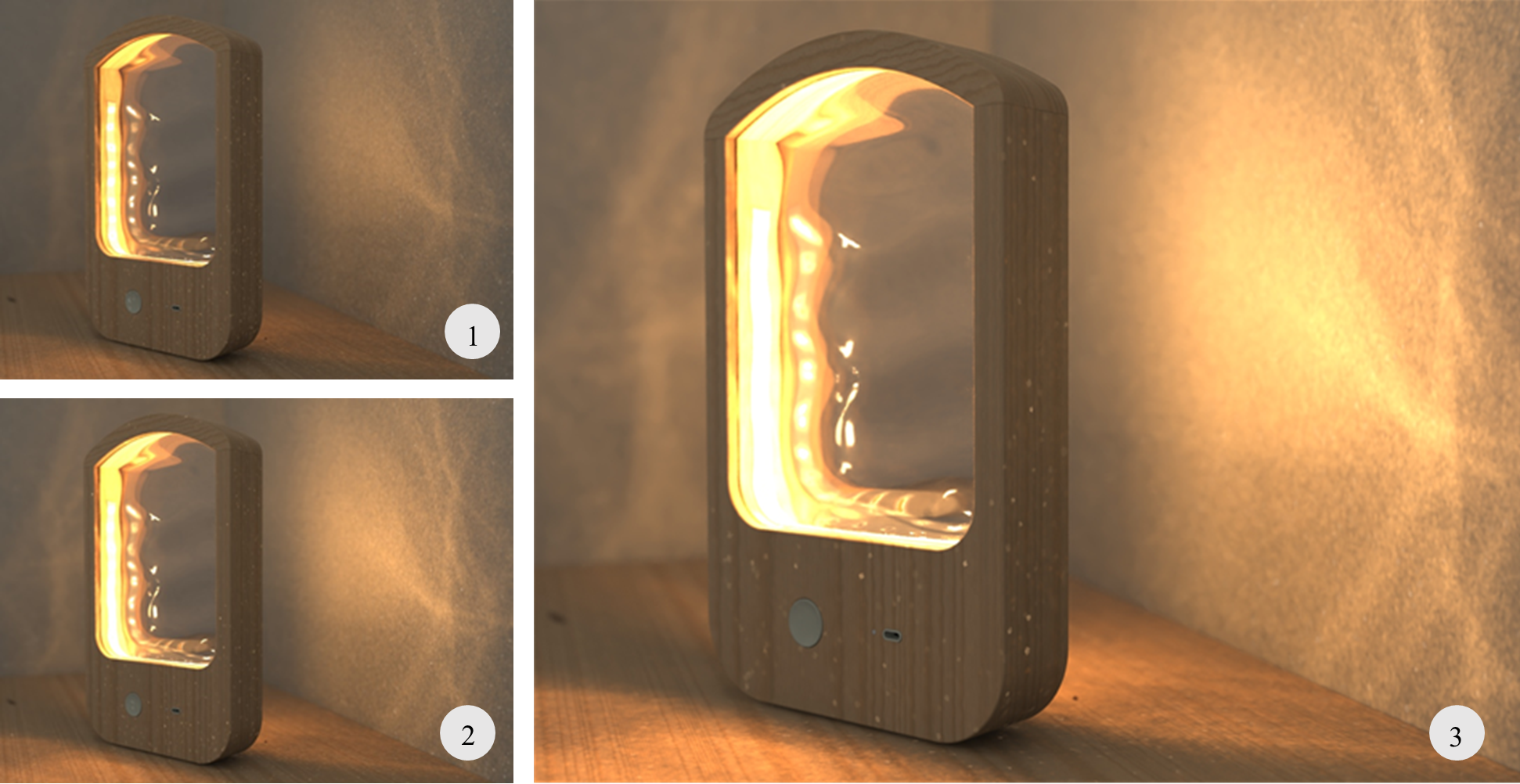
Figure 10. Luminaire lit at 25% (1), 50% (2) and 100% (3) of its power.
The luminaire resulting from a process of user-centred research and industrial design and product development is therefore briefly presented. A subsequent phase will be the physical and functional prototyping. This will allow the result to be tested and verified with the user as a final stage of the User-Centred Design process to discover whether it satisfies the needs discovered and to identify possible changes to refine the final design.
Conclusions
User-Centered Design is an increasingly used approach in industrial design as well as in other fields of design (services, digital products...). Through this research and design project, it has been intended to explore the different stages that must be followed to design new products: knowing the user’s context, a creative ideation, sketching and the definition of the design proposal, among others.
Nevertheless, the greatest emphasis was placed on user research in order to create, in this case, a luminaire that would respond to their needs and concerns. Creative techniques were used, with creative being understood as those designed specially to obtain specific information. An example of this where the shadowings to understand habits and routines related to light.
Each technique applied in the research has its justification in the results of the previous tool, underlining the iterative character of User-Centered Design. For example, the interviews were conducted after the shadowings so as to be able to answer certain doubts noted during observations. The interviews were also used to check and compare what the user says and does.
This combination of shadowings - contextual interviews has proven to be effective in obtaining a complete picture of users’ context. While observations provide a snapshot without the distortion of the user’s perspective, interviews give the opportunity to understand how the user perceives his or her reality and environment.
Given that shadowings and interviews were conducted with the same participants, it might have been more fruitful for the research to have more personalised the script of each interview in order to learn and extract more nuances from each user. Nonetheless, the observations from the shadowings led the way in finding new ways of adapting lighting to diverse leisure and loosening activities from everyday life. They helped study and understand the current interactions with light with a view to designing the luminaire. The analysis of the use that users made of their static lamps and excessive or insufficient light intensity in uncomfortable positions and locations led the work towards the portable lamp with dimmable intensity, allowing the user to place the luminaire wherever he/she wishes at any time with the intensity that suits him/her best. In other words, shadowings provide the opportunity to study how users use products so that new usage patterns, functions and technologies can be designed to adapt to people’s needs and habits.
Although the fictitious personas keep no direct connection with the final design, they have been very useful during the design process to be able to keep the user in mind. This was since in their definition; the profiles reflect more superficially the findings of the research phase. Thus, it is easier to associate the problems and needs with the target user. This provides a framework built from the actual observations and interviews previously conducted.
The technique that could be considered the most avant-garde and connected to the user is cultural probes. It creates an intimate channel of communication outside an environment that can condition the user. Instead of feeling studied, this tool achieves a more playful and personal approach. It is the user who decides what information to give the researcher. The findings are less superficial and are related to the participants’ viewpoints and reflections on the main topic of the project as well as others in their context.
Using this method, it was possible to identify other needs and desires of users, such as greater contact with nature. The responses obtained influenced the final design, as they included information about the environments and contexts in which this sense of tranquillity and calmness would arise. For example, the sunset on the seashore, with the waves rolling in. This would later be essential, as the optical effects of the lamp try to emulate this moment to sensorially engage the user.
One final detail of user-centered research is worth noting. People are interested in participating because they do feel that the new products that emerge from the research are designed to respond to their needs and desires. Therefore, if techniques that favour their participation are used and explained in a precise way, people are predisposed to get involved, even more than the researcher expects. Consequently, this results in very useful and interesting findings for the design team to translate into products.
This project follows this line, i.e., the research findings underpin the final design, as the design and development process are nurtured by the personas created and the insights revealed. After the research and ideation comes the product development process. Besides what is presented in this article, other more technical aspects of Industrial Design and Engineering, like luminaire connections or compliance with the associated regulations, are explored in further detail.
Despite being a methodology that is nowadays better implemented in the design of digital products, its irruption in the physical product can be differentiating and innovative. It justifies designs, generating a value proposal and giving them a personality oriented to user and interaction experience, where the product responds to the person’s needs.
In conclusion, this project aims to highlight the need for a correct research phase following the User-Centered Design methodology so that new products respond to people’s needs, regardless of the field of design being addressed. Products will therefore have a better reception in the market afterwards, as well as a great deal of support based on knowledge of the user and his or her habits and needs. It is an open methodology, which must be designed and adapted to each user and product to extract the most relevant information.
The work addressed in this article could have been complemented with a larger number of users or by using other techniques that would have permitted observing how the user interacts with lighting objects to further enrich the subsequent insights. Thus, a further line of research is opened that involves the prototyping and verification of the design presented here to study user acceptance and possible improvements. Above all, in terms of product interactions to better adapt it to people’s needs and habits, which is the ultimate goal of this methodology.
